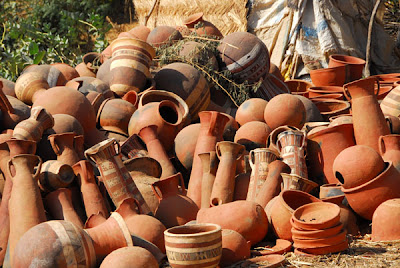[dropcap custom_class=”normal”] Timi Dakolo is a Nigerian singer born to a Nigerian father and a Ghanaian mother. He won in the first season of Idols West Africa in 2007. Timi Dakolo is blessed with powerful vocals, and has a world class stage performance. Timi Dakolo’s rich choice of words, depth of lyrics has made him stand out among his contemporaries. [/dropcap]Continue reading
Bellafricana launches The Marketplace For Afrocentric And Handmade Products
[dropcap custom_class=”normal”] Bukky Bello who is the founder of Bellafricana shares with Bellafricana digest viewers the launch of an online marketplace for Afrocentric and Handmade products in Africa (starting with Nigeria her homeland) with the aim of promoting local content through the connection of local artisans, talents and creatives to the global reach. Let’s hear her story… [/dropcap]
Spotlight Wednesday | Muraina Oyelami
[dropcap custom_class=”normal”]Chief Muraina Oyelami is a man of two worlds, popularly known as a master painter a great performing artist in music and theatre. He is a product of the famous Oshogbo Art Movement initiated by Professor Ulli Beier and his wife Georgina Beier. In 1964, he started his career as an artist. He studied technical theatre and specialized in theatre design at the Obafemi Awolowo University, Ile Ife, where he later taught traditional music from 1975 to 1987.[/dropcap]Continue reading
The African Talking Drum
[dropcap custom_class=”normal”]A talking drum is an ancient hourglass shaped African instrument. It is created by the Yoruba people of Nigeria and the Ashanti people of Ghana . It is also called a “waisted” drum because it has an hourglass shape with a “waist” in the middle. [/dropcap]Continue reading
Meet Opemipo Ogunyemi "The Shoe Crafter" | Exclusive Interview
[dropcap custom_class=”normal”] This young man right here is an entrepreneur with a great passion for shoe crafting. I met him at Creative focus, a competition for entrepreneurs I was fortunate to attend in year 2014. You’ll be surprised the number of talents we have in Africa, but not to worry the Bellafricana team will bring them to you one at a time. Lets meet him; [/dropcap]
Meet Folarin Falana "The Rapper" | Exclusive Interview
[dropcap custom_class=”normal”] For all those who know Folarin aka Falz the Bahd Guy, I’m sure you must agree with me at his level of humility and humor. I met Falz a couple of years ago through one his awesome sisters, Foladele Falana. Falz is the son of the popular respected lawyer Femi Falana. He is a Barrister with a strong passion for music and entertainment. He is an upcoming artist, who is very loved by today’s youths. I was so interested to hear his story, so I thought to share with you on the digest. [/dropcap]
The Making Of African Clay-Pot
Pottery has a long history in Africa and is one of the oldest arts. Pots are usually made by women. Though cheap and functional, African pots combine utility with great beauty. The procedure for making pots vary within the different communities that span the continent. The process of pottery making in Africa begins with the mining and preparation of the clay and mixing it with water.
Women Mining Clay
Women mining clay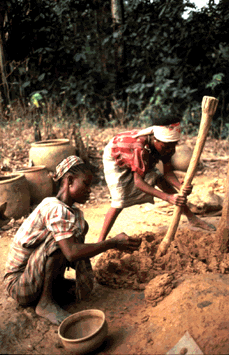
Photos by Prof. Christopher Roy
Clay Preparation
Temper or inert matter is then added to the clay mixture so as to reduce plasticity and to decrease shrinkage of pottery by replacing clay molecules, which contain water that shrink during drying and firing.
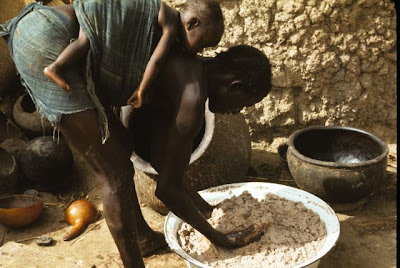
Temper includes finely chopped straw, dried animal dung pounded into a powder, and the chaff left when rice or millet is winnowed to prepare it for cooking, sand, river pebbles, shards of old pottery which have been reduced to a find powder. Tempers are kneaded into the fresh clay in amounts that vary. Generally, the result is a clay body with thirty to fifty percent temper material.
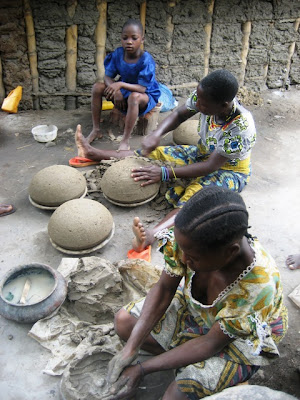

Starting with a mass of clay, most potters work by punching a hole in the center, and pulling the clay apart to give a vessel shape. Some flatten a clay shape over a convex mold and build up a vessel with coils. The potter’s wheel is uncommon in Africa. When they are ready for firing, a few large pots and many small ones are stacked together. Then they are wood fired for about three hours at relatively low temperatures. Some communities use pits and kilns.
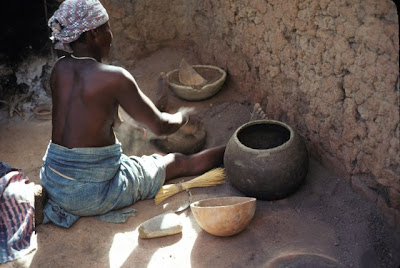


Pre-firing decoration is generally permanent and will survive handling and extensive use of the pot. In contrast, post-firing decoration, such as painting or colored washes, never becomes an integral part of the pot and will eventually wear off the surface.
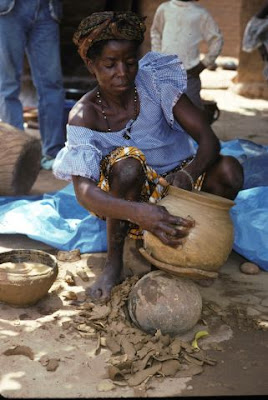
Pre-firing decoration is applied at different stages in the drying process, after the completion of the basic shape of the pot and before the firing. Simple decorations include ones incised into the damp clay with a sharp blade or comb-like tool, impressed with a stamp made for example from split seed pods or shells, or rolled with a roulette made from a dried corn cob from which the kernels have been removed. Pre-firing also helps to drive the last molecules of absorbed water between the clay particles.
Here a potter of the Konate family in the village of Ouri in Burkina Faso prepares to fire large jars that will be used for brewing millet beer.

To pre-fire larger pots, they are turned rim downward on three large stones which keep them off the ground. A small fire is built beneath each pot to complete the drying process. When the pots are sufficiently dry, they are stacked with others for the final firing. The final firing must be begun before the pots have cooled from the pre-firing. If pottery is allowed to cool after the pre-firing, it will re-absorb moisture from the atmosphere and will crack during the final firing. Pre- firing is usually not necessary in the dry savanna where the lack of humidity permits more complete drying of the pottery before firing.
FIRING IN A KILN
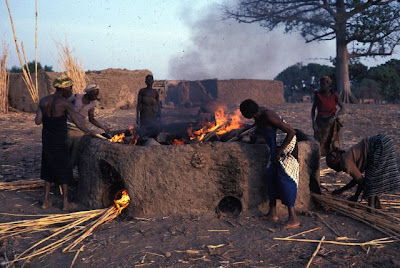
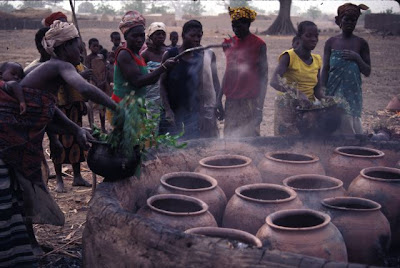
The kiln consists of a low, circular, mud brick wall, with pierced small holes on the base of the which provides air for the firing. Some kilns also have one or more larger holes that permit the addition of fuel during the course of the firing.
A thick layer of fuel is laid over the bottom of the kiln. Then, the dry pottery, interspersed with additional fuel, is piled on top which is then covered with large pieces of broken pottery that helps retain some heat and protect the pottery from direct contact with cool air. The kiln is lit from the bottom.
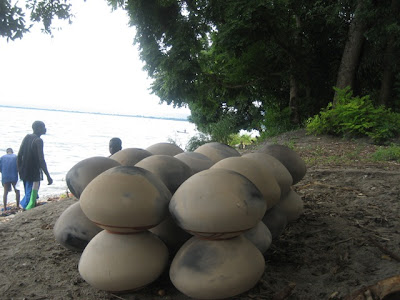
The duration of African firings is very short when compared to the technically complex and lengthy firings of European, American, and Oriental potters.

Once pottery has been fired its basic shape cannot be altered.
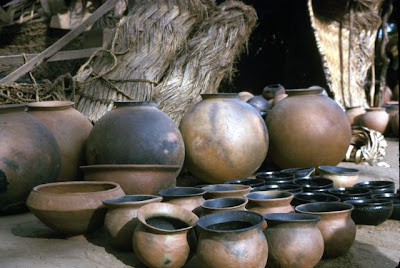



Source: saharanvibe.blogspot.com
Spotlight Wednesday | Ablade Glover
[dropcap custom_class=”normal”] Ablade Glover has had the benefit of training in countries such as Ghana, Britain and the United States. In the course of this, he has garnered a number of distinctions, showing his importance as an artist and enthusiastic educator both nationally and internationally. [/dropcap]
Peniel Enchill | The Ghanian Illustrator
[dropcap custom_class=”normal”] Ok so I couldn’t help but write about this talented young lady. I actually don’t know her personally but I follow her on Instagram and I also see her work flying all around my social networks, so yes she caught my attention (yes, I’m that bothered LOL). You see I like to dig deep to meet the talent behind any creative work, it inspires me. Her full name is Peniel Ewurama Enchill, born in Ghana and was raised in England. An African talent doing great things. Check out some of her portfolio.. I sure can’t wait to do an Exclusive Interview with her… [/dropcap]
Continue reading
Meet The Founder Of Ty-Tys | Exclusive Interview
[dropcap custom_class=”normal”] The first time I was opportuned to meet Mr Bayo Ademiluyi (founder of Ty-tys) was at the Chevron (Afro-centric) bazaar. It was so random as one of the Bellafricana team had just posted an article about Ty-tys which caught my attention. Mr Ademiluyi is very jovial, down to earth and talented of course. I couldn’t help but interview him to hear the story of how Ty-tys came about. [/dropcap]


